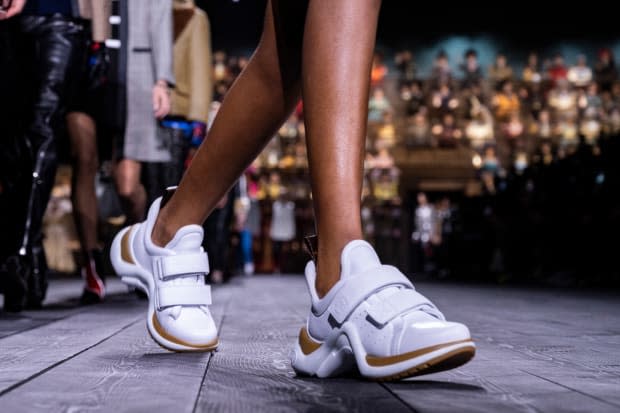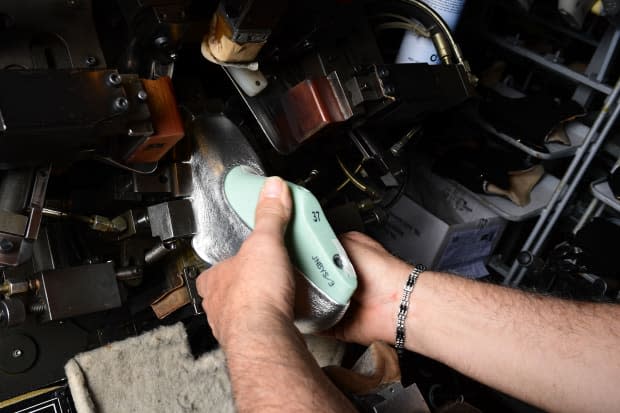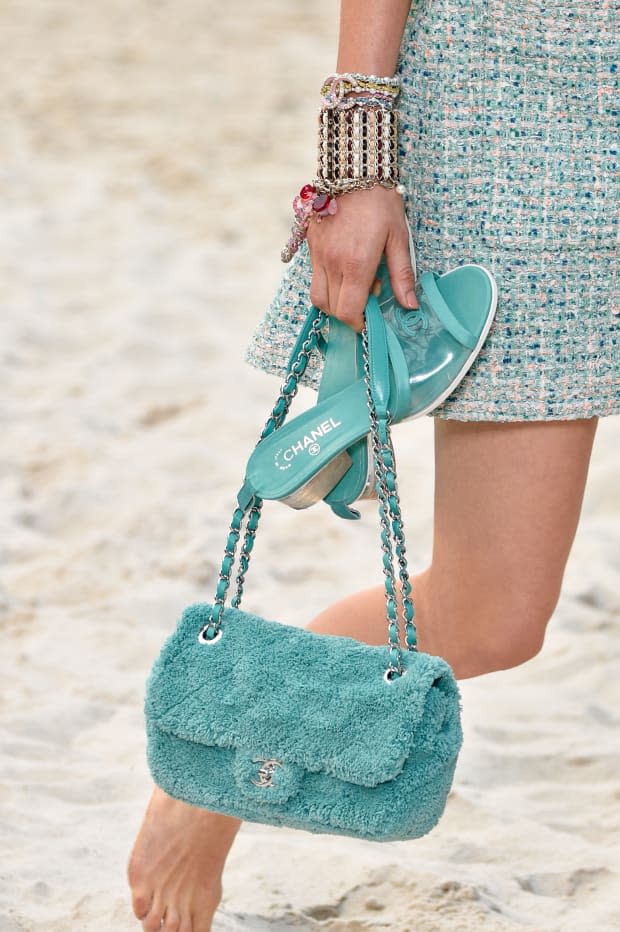For Behind-the-Scenes Shoe Designers, the Glory Is in the Craft
At luxury houses, shoes play an integral role in the artistic and commercial success of the company. But they're so much more for the people designing them.
The most iconic shoes in history have impacted a culture, not just a collection.
I didn't mean to get so hyperbolic right out of the gate, but sometimes, a subject demands it. In this case, that subject is shoes. Those devices cavepeople wore to protect their feet from the elements have since, 40,000 years later, become a critical part of our world.
Speaking financially, the U.S. footwear market is expected to reach a global revenue of $280 billion by 2023. Speaking societally, styles like Converse All Stars and Alexander McQueen's Armadillo boots have come to represent a movement as much as a moment in time.
And for fashion houses, operations that have built billion-dollar businesses on clothing and accessories, shoes are a paramount part of the ecosystem. Fabrizio Viti, the Italian footwear designer who has served as Louis Vuitton's head shoes style director since October 2004, has had decades to internalize this responsibility.
"I have to do my part, which is a very important part because as you know, there could be shows without bags, shows without sunglasses," Viti tells me over the phone from Paris. "But there are no shows without shoes. The shoes define the silhouette."
Viti has the kind of high-gloss resume that designers find themselves fantasizing about during quiet moments of studio time: In one of his very first jobs, he worked alongside Tom Ford at the fabled Ford-era Gucci, then spent five years with Miuccia Prada at Prada. By 2004, Marc Jacobs had hired him at Louis Vuitton, and in 2016, he launched his own self-named standalone luxury label.
At Louis Vuitton or Prada or Gucci, Viti has been something of a secret weapon. He's helped create some of the house's most lucrative pieces in recent years, working across design teams to bring an all-encompassing vision to life. And while Viti is widely known in fashion circles, he's not quite a household name like artistic director Nicolas Ghesquière.
Head footwear designer live and breathe the production and the craft as much as they do the final runway show, for which they do not take a bow. Their work lives primarily behind the scenes, in family-run factories and intimate studios, where they create shoes that may very well impact a culture, not just a collection.

Like many footwear designers, Viti began his fashion career in clothing design, studying prêt-à-porter at Milan's Istituto Marangoni before taking a sculpture course in the marble-rich city of Carrara. Here, he found a certain satisfaction in creating shoes that he did not in clothing.
"I realized I don't love fabric that much because it falls down," jokes Viti. "I realized that shoes are more like a sculpture because you have to mold the heel, you have to basically do a little sculpture. And this was something very personal to me."
Viti trained in sun-soaked Italy, where the Western Hemisphere's artisanal shoemaking trade developed as a cottage industry in the mid-19th century. Between 1830 and 1900, the San Mauro Pascoli commune began distinguishing itself as the regional capital of high-end women's shoes manufacturing. So many citizens worked as cobblers, repairing shoes on their doorsteps and bartering their work with food, that in 1901, the shoemaking community was granted its own state flag.
Today, the district's manufacturers — many of which are owned and operated by the same families that first established them a century and a half ago — have a tradition to uphold. At research center and international footwear school Centro Ricerca e Scuola Internazionale Calzaturiera (CERCAL), curriculum revolves around that "Made in Italy" label, which mandates a baseline of production steps rooted in historical techniques.
Related Articles
Fashionista's 101 Favorite Shoes From the Fall 2020 Shows
Christian Louboutin's New Paris Exhibit Looks Beyond the Red Sole and Into the Man Behind It
How the Way We Shop for Sneakers Has Changed Over the Past Decade
In Italy, these guidelines are spare no detail. Shoes must be kept on lasts, a wooden or plaster form shaped like a human foot around which the shoe gets built, overnight or over an even longer period of time. The heel, too, must be set on asymmetrically to reflect the organic nature of our builds. And there are many, many more boxes to tick.
"It can be challenging, obviously, but a shoe is 20 different components coming from 20 different factories that all have to fit together within a millimeter," says shoe designer Christopher Viggiano, who studied at CERCA in 2010 and has since worked in design and product development for brands like Band of Outsiders and Acne Studios. "You become obsessive."
Footwear is obsessive for a reason, and not simply because it's the product of generational heritage and regional identity. Shoe designers have a duty to protect physiology in a way that those in the clothing, handbag or jewelry space do not. As Chanel's longtime head shoe designer, this is chief priority for Laurence Dacade, who launched her own eponymous luxury label in 2008 in tandem with her years of collaboration with Creative Directors Karl Lagerfeld and Virginie Viard.
"Shoes are always a challenge because you can never say, 'Oh, my jacket is hurting me.' But shoes can hurt you," Dacade explains on a call from Paris."You have to design a shoe you're going to love, not only because it's beautiful, but mainly because you feel so comfortable in it. It has to be all together."

The process is so intense, so entrenched in cultural mores, that Viggiano suggests that shoe designers can't help but become obsessed with their craft, and perhaps that's what sets them apart from other major categories beneath a fashion house's umbrella.
"There's little things that matter in terms of the anatomy of the foot that make a big difference in holding up the body weight and the structure. You're making little architectural buildings, you know?" he says. "A really good shoe designer is also a really good technician and a really good product developer. You're forced to do all three."
That's not to say that each faction of a fashion brand isn't as multidimensional as it may be in the shoe department. Couture ateliers, of course, are almost mythically rooted in practices that were inaugurated in the 17th century. When footwear designers enter a legacy label, they bring with them a commitment to honor not only the greater creative direction of the collection, but also the artisans behind the curtain.
"I can tell the best shoes when their designer had been sitting there in the factory with all of the artisanal leather workers actually toiling, coming up with solutions, putting on the fine details," says Viggiano. "There's a lot more digging in, being in the factory, than there is with clothing."
At Louis Vuitton, Viti understands the role he plays alongside Ghesquière in conceiving the personage of each show. Together, they develop what they call a "personality," a woman who actually exists beyond the walls of their studio because, as Viti says, these things are meant to be worn.
"In a way, with Nicolas, it's like being part of a movie," explains Viti. "It's a script, and he's the director. I have to step out of myself somehow. How can I mix what I have to do and what it is that I want to do?"
The answer to this question does not exist on the opposite end of a formula, carefully calculated by professionals like Viti or Dacade over the course of years. Instead, to design for a legacy brand like Louis Vuitton or Chanel requires some amount of coloring within the lines — but you may just get to retool what, exactly, those lines are.
"I'm looking at them and I try to give them what they expect from me," says Dacade, who has also been the woman behind the shoes for Givenchy and Kenzo. "I try to give them something that's in the mood of their story, the story of the designer, the story of the brand. I put myself, my vision, in a position to be in their world. To feel their world."

At any fashion house, those lines cannot expand or retract without the input of other voices. There is trust placed between a footwear designer and the house's artistic direction, certainly, but also between the brand's corporate management. Shoes can only shape a culture if they sell.
"What's important is what you give at this moment. When I think of Chanel, I give something different when I started than what I'm giving today. It's like building a garden. You plant a seed, and then you see that people like it, and you make it grow and grow."
In recent seasons, le jardin de Chanel has blossomed: Spring 2018's clear PVC rain boots, which extended over-the-knee and featured the house's signature cap-toe detailing; the same season's haute couture ankle boots, hazily transparent and bedecked in a menu of delicate embroidery like jeweled flowers or candy-colored tweed; Spring 2019's beachy espadrilles, many of which came hanging off a bag with a Chanel-branded carabiner. Each pair is a far cry from the brand's ubiquitous slingbacks, designed by Coco Chanel herself in 1957 in an attempt to mimic men's brogues. But they are Chanel shoes through and through. The house codes may not be explicit, but they are there in the two-tone palettes, block heels, double-C embellishments.
"When you know what you want to do, you can do everything," says Viti. "And brands like Louis Vuitton are not monster brands — they're just brands that give us the possibility to experiment and to work in a very intelligent way. Of course, you have to give them what they want, but on the other hand, you have a lot of freedom and possibilities."
For those head footwear designers like Viti and Dacade who also operate their own labels, the workload is considerable, and steadily swelling. Fashion is in the throes of a significant burnout problem, employing a breathless pace that can wind even the most seasoned industry fixtures.
But it is their craft, and designers have an obligation not simply to their fashion houses or their factory partners, but to themselves. They may be just shoes to some, but to others, from those cobblers in San Mauro Pascoli to the artisans forming the lasts, shoes are an entire world.
"I give everything. At the end of the day, I want to think, 'That was amazing. What a fantastic life to have, to have this opportunity to work with these people,'" says Dacade. "Every piece of work makes you grow, and it's always difficult, whatever it is. The more you're doing, the stronger you are. And there's no limit with that. I feel endless creativity."
Want more Fashionista? Sign up for our daily newsletter and get us directly in your inbox.
